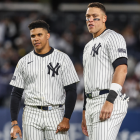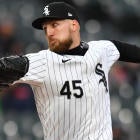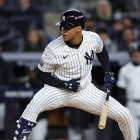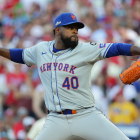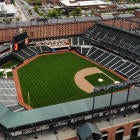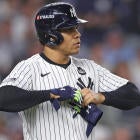
More MLB: Scoreboard | Standings | Probable Pitchers | Sortable Stats | Odds
When a team is going like the Dodgers are going, the losses start to feel reverse-engineered. You begin from the premise of an inevitable loss, and then you work backward to how that loss happened. Sunday's defeat at the hands of the Braves certainly had that veneer.
To recap, the Dodgers took a 2-1 lead into the bottom of the eighth, at which point quasi-closer Brandon League, to euphemize, soiled the very place he sleeps at night. League inherited two baserunners from Kenley Jansen and yielded the following sequence of events: sac bunt, line-drive single, sac fly, line-drive single, sac bunt, walk, strikeout. None of the runs were charged to League, but he did an awful job of playing "fireman." Had the Braves not given him outs, it's not certain he could've gotten more than one.
And therein lies the point of this departure. Of all the dubious moves Dodgers GM Ned Colletti has concocted, of all the ill-advised salary commitments he's taken on, his signing of League may be the worst of them all.
Sure, there's a case to be made that inking a lumbering, platoon-challenged hitter like Andre Ethier into his deep-decline phase is more damaging, or that Colletti's "leveraged buyout" of the Red Sox's deepest problems has more potential for calamity. But none is as puzzling as his decision, last October, to sign League to a three-year, $22.5 million extension with a vesting option for 2016 that could push the total value of the deal to $31.5 million.
Let's say nothing of the time-proved notion that it's a bad idea to pay the going rates for closers or closer-ish types on the free-agent market. Instead, let's focus on what Colletti should have seen in League when the thought crossed his mind to offer him such a pact:
- Colletti should have seen a reliever who in 2012 experienced a massive spike in his walk rate (from a 4.0 BB% in 2011 to an 11.0 BB% in 2012);
- He should have seen a reliever who in 2012 benefitted from a completely unsustainable home-run/fly-ball rate of 2.1 percent;
- He should have seen a pitcher experiencing broad-based, if modest, velocity loss;
- He should have seen a pitcher with established weaknesses against the opposite side;
- Most fundamentally, Colletti should have seen that League's career runs-per-nine mark of 4.23 is far from optimal by the standards of late-inning relievers.
Instead of all this, Colletti, presumably, saw a guy who racked up lot of saves in 2011 and looked good over a miniscule sample of 27 1/3 innings after he acquired him from Seattle at 2012 non-waiver deadline. That's simply not a thought process that should be taking place inside the brain of a major-league general manager, at least not these days.
This is the problem with Colletti writ small, and it's why if pinks slips are going to start flying at Chavez Ravine, then the first one should land on Colletti's desk. As mentioned, you can argue that other deals executed on his watch are more onerous and more troubling insofar as the distant future is concerned, but the League deal is worse in that it suggests Colletti is simply out of his depth, particularly on such a deep-coffered team.









